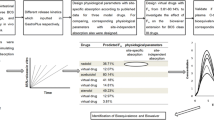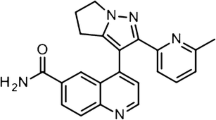Abstract
Purpose
Cyclodextrin (CD) is commonly used to enhance the solubility of oral drugs. However, with the increase of CD concentrations, the fraction of free drug molecules decreases, which may potentially impede drug absorption. This study aims to predict the optimal ratio between drug and CD to achieve the best absorption efficiency by computational simulation.
Methods
First, a physiologically based pharmacokinetic (PBPK) model was developed. This model can continuously adjust absorption according to free drug fraction and was validated against two model drugs, progesterone (PG) and andrographolide (AG). The further analysis involves 3-D surface graphs to investigate the relationship between free drug amount, theoretically absorbable concentration, and contents of drug and CD in the formulation.
Results
The PBPK model predicted the PK behavior of two drugs well. The concentration ratio of drug to CD, leading to maximal free drug amount and the best absorption efficiency, is nearly the same as the slope determined in the phase solubility test. The new modified PBPK model and 3-D surface graph can easily predict the absorption difference of formulations with various drug/CD ratios.
Conclusion
This PBPK model and 3-D surface graph can predict the absorption and determine the optimal concentration ratio of CD formulation, which could accelerate the R&D of CD formulation.








Similar content being viewed by others
References
Di Maio S, Carrier RL. Gastrointestinal contents in fasted state and post-lipid ingestion: in vivo measurements and in vitro models for studying oral drug delivery. J Control Release. 2011;151(2):110–22. https://doi.org/10.1016/j.jconrel.2010.11.034.
Williams HD, Trevaskis NL, Charman SA, Shanker RM, Charman WN, Pouton CW, et al. Strategies to address low drug solubility in discovery and development. Pharmacol Rev. 2013;65(1):315–499. https://doi.org/10.1124/pr.112.005660.
Challa R, Ahuja A, Ali J, Khar RK. Cyclodextrins in drug delivery: an updated review. AAPS PharmSciTech. 2005;6(2):E329–57. https://doi.org/10.1208/pt060243.
Rong WT, Lu YP, Tao Q, Guo M, Lu Y, Ren Y, et al. Hydroxypropyl-sulfobutyl-beta-cyclodextrin improves the oral bioavailability of edaravone by modulating drug efflux pump of enterocytes. J Pharm Sci. 2014;103(2):730–42. https://doi.org/10.1002/jps.23807.
Dahan A, Miller JM, Hoffman A, Amidon GE, Amidon GL. The solubility-permeability interplay in using Cyclodextrins as pharmaceutical Solubilizers: mechanistic modeling and application to progesterone. J Pharm Sci. 2010;99(6):2739–49. https://doi.org/10.1002/jps.22033.
Beig A, Agbaria R, Dahan A. Oral delivery of lipophilic drugs: the tradeoff between solubility increase and permeability decrease when using cyclodextrin-based formulations. PLoS One. 2013;8(7):e68237. https://doi.org/10.1371/journal.pone.0068237.
Beig A, Agbaria R, Dahan A. The use of captisol (SBE7-beta-CD) in oral solubility-enabling formulations: comparison to HP beta CD and the solubility-permeability interplay. Eur J Pharm Sci. 2015;77:73–8. https://doi.org/10.1016/j.ejps.2015.05.024.
Fine-Shamir N, Beig A, Zur M, Lindley D, Miller JM, Dahan A. Toward successful Cyclodextrin based solubility-enabling formulations for Oral delivery of lipophilic drugs: solubility-permeability trade-off, biorelevant dissolution, and the unstirred water layer. Mol Pharm. 2017;14(6):2138–46. https://doi.org/10.1021/acs.molpharmaceut.7b00275.
Sun L, Zhang B, Sun J. The solubility-permeability trade-off of progesterone with Cyclodextrins under physiological conditions: experimental observations and computer simulations. J Pharm Sci. 2018;107(1):488–94. https://doi.org/10.1016/j.xphs.2017.09.032.
Yu LX, Amidon G, Khan MA, Hoag SW, Polli J, Raju GK, et al. Understanding pharmaceutical quality by design. AAPS J. 2014;16(4):771–83. https://doi.org/10.1208/s12248-014-9598-3.
Zhao L, Kim MJ, Zhang L, Lionberger R. Generating model integrated evidence for generic drug development and assessment. Clin Pharmacol Ther. 2019;105(2):338–49. https://doi.org/10.1002/cpt.1282.
Hartmanshenn C, Scherholz M, Androulakis IP. Physiologically-based pharmacokinetic models: approaches for enabling personalized medicine. J Pharmacokinet Pharmacodyn. 2016;43(5):481–504. https://doi.org/10.1007/s10928-016-9492-y.
Christodoulou E, Kechagia IA, Balafas E, Kostomitsopoulos N, Archontaki H, Dokoumetzidis A, et al. Serum and tissue pharmacokinetics of silibinin after per os and i.v. administration to mice as a HP-β-CD lyophilized product. Int J Pharm. 2015;493(1–2):366–73. https://doi.org/10.1016/j.ijpharm.2015.07.060.
Taupitz T, Dressman JB, Buchanan CM, Klein S. Cyclodextrin-water soluble polymer ternary complexes enhance the solubility and dissolution behaviour of poorly soluble drugs. Case example: Itraconazole. Eur J Pharm Biopharm. 2013;83(3):378–87. https://doi.org/10.1016/j.ejpb.2012.11.003.
Gao H, Su Y, Wang W, Xiong W, Sun X, Ji Y, et al. Integrated computer-aided formulation design: A case study of andrographolide/ cyclodextrin/ TPGS ternary formulation. Asian J Pharm Sci. 2021 (Accepted).
Yu LX, Crison JR, Amidon GL. Compartmental transit and dispersion model analysis of small intestinal transit flow in humans. International Journal of Pharmaceutics. 1996;140(1):111–8. https://doi.org/10.1016/0378-5173(96)04592-9.
Peters SA. Physiologically-based pharmacokinetic (PBPK) modeling and simulations: principles, methods, and applications in the pharmaceutical industry. John Wiley & Sons 2012.
Yang T, Xu C, Wang ZT, Wang CH. Comparative pharmacokinetic studies of andrographolide and its metabolite of 14-deoxy-12-hydroxy-andrographolide in rat by ultra-performance liquid chromatography-mass spectrometry. Biomed Chromatogr. 2013;27(7):931–7. https://doi.org/10.1002/bmc.2884.
Panossian A, Hovhannisyan A, Mamikonyan G, Abrahamian H, Hambardzumyan E, Gabrielian E, et al. Pharmacokinetic and oral bioavailability of andrographolide from Andrographis paniculata fixed combination Kan Jang in rats and human. Phytomedicine. 2000;7(5):351–64. https://doi.org/10.1016/s0944-7113(00)80054-9.
Du H, Yang X, Li H, Han L, Li X, Dong X, et al. Preparation and evaluation of andrographolide-loaded microemulsion. J Microencapsul. 2012;29(7):657–65. https://doi.org/10.3109/02652048.2012.680508.
Ye L, Wang T, Tang L, Liu W, Yang Z, Zhou J, et al. Poor oral bioavailability of a promising anticancer agent andrographolide is due to extensive metabolism and efflux by P-glycoprotein. J Pharm Sci. 2011;100(11):5007–17. https://doi.org/10.1002/jps.22693.
Kuemmel C, Yang Y, Zhang X, Florian J, Zhu H, Tegenge M, et al. Consideration of a credibility assessment framework in model-informed drug development: potential application to physiologically-based pharmacokinetic modeling and simulation. CPT Pharmacometrics Syst Pharmacol. 2020;9(1):21–8. https://doi.org/10.1002/psp4.12479.
Jambhekar SS, Breen P. Cyclodextrins in pharmaceutical formulations I: structure and physicochemical properties, formation of complexes, and types of complex. Drug Discov Today. 2016;21(2):356–62. https://doi.org/10.1016/j.drudis.2015.11.017.
Zhao Q, Ye Z, Su Y, Ouyang D. Predicting complexation performance between cyclodextrins and guest molecules by integrated machine learning and molecular modeling techniques. Acta Pharm Sin B. 2019;9(6):1241–52. https://doi.org/10.1016/j.apsb.2019.04.004.
Author information
Authors and Affiliations
Corresponding author
Additional information
Publisher’s Note
Springer Nature remains neutral with regard to jurisdictional claims in published maps and institutional affiliations.
Supplementary Information
ESM 1
(DOCX 502 kb)
Rights and permissions
About this article
Cite this article
Wang, W., Ouyang, D. Prediction of Free Drug Absorption in Cyclodextrin Formulation by a Modified Physiologically Based Pharmacokinetic Model and Phase Solubility 3-D Surface Graph. Pharm Res 38, 1157–1168 (2021). https://doi.org/10.1007/s11095-021-03071-3
Received:
Accepted:
Published:
Issue Date:
DOI: https://doi.org/10.1007/s11095-021-03071-3




